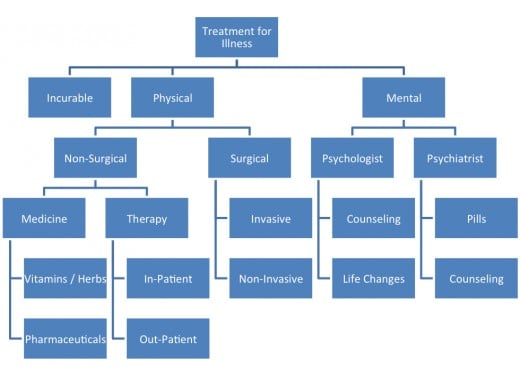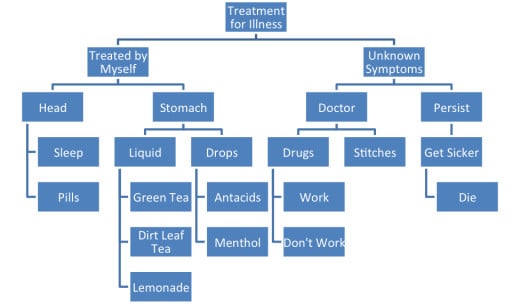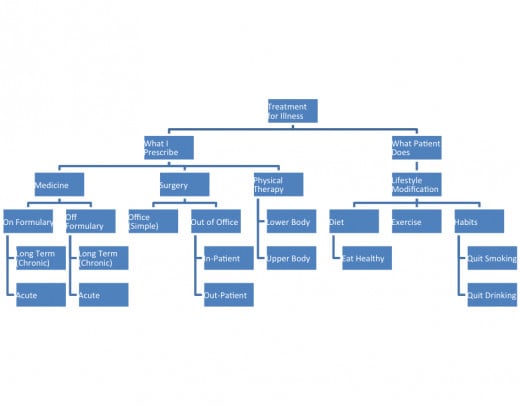Ethnosemantic Project -Treatments for Illness by Brian Brijbag
Preface
This short ethnosemantic paper was a semester long project completed for ANT 4462 "Health, Illness, and Culture" at the University of South Florida. The undergraduate course was taught by Roberta Baer, Ph.D. in the Fall of 2011.
Introduction
We find in our North American culture many different systems for cataloguing and identifying data. Almanacs, dictionaries and spreadsheets are a few of the ways that our understanding has been institutionalized. In this same way, Ethnosemantic research is a method of cataloguing the practices of a particular community. Hence, ethnosemantics is a form of scientific study based on an empirical collection of the understanding of knowledge.
In my attempt to add to the discussion of building a culturological map as it concerns a community’s understanding of “treatments for illness,” I interviewed three individuals. One is a typical mainstream American who is steeped in North American culture. Secondly, I spoke with a young Haitian man studying here in the United States. Finally, I spent some time with a seasoned heath professional who is a product of the American medical system.
This project will partner with the objectives of the class to focus on the influence of culture on beliefs and behaviors about health and illness in American society. In particular, it will concentrate on three individual perspectives on the types of treatments that can be undertaken in regards to illness. From there, the findings of this study will be combined with those of other students doing similar work to be compared and contrasted with the aim to produce conclusions on healthcare interactions based on a larger data set.
For the purpose of this study, no definition for terms like “treatment” or “illness” were assumed or introduced. The subject was entirely left to their own devices as to conceptualizing these terms. The only prompt given was “Treatments for Illness”. Each subject was introduced to the concept of ethnosemantic exercises by working them through the example of “dog”.
Subjects
This project was conducted with the following three subjects:
James - Mainstream American
Donald - Ethnic American
David - American Medical Professional
Mainstream American
James – Male (Age 25)
James presents as a typical male of 25 years old whom has been raised in Florida. He is married without kids and did not proceed any further than high school. James is a small business owner, having purchased an existing sandwich restaurant two years ago. In April of this year, James was involved in a car accident that did not require any immediate medical attention. One week later, while working, he became dizzy and disoriented. He was admitted to the hospital and released the next day. After the symptoms got worse, he was readmitted to the hospital and diagnosed with a stroke that resulted due to a clot from the car accident. James is currently suing the hospital for their “lack of treatment.”
In James’ ethnosemantic chart for “Treatments for Illness,” he identified “incurable” as one of his first divisions. This perspective may be surprising from a 25 year-old male as we normally associate them with an attitude of invincibility. With his recent accident and stroke, abnormal for a 25 year-old in otherwise good health, it is possible that James has been wrestling with issues concerning the fragility of life.
Outside of that, the rest of his chart was plotted out as expected by the researcher. Influenced by American television, movies and school system, James described what might be assumed to be the totality of modern medicine. What may be more of interest would be what he did not mention. James did not mention any role for faith, divine intervention or other seemingly non-verifiable treatment methods. Each option could be argued for with empirical evidence.
James does allow in his worldview a place where mental illness exists and can be treated. While seeing counseling as a common method for treating this type of illness, he sets “Life Changes” and “Pills” as competing opposites. To James, the only difference between a Psychologist and a Psychiatrist is the ability to prescribe medication as a treatment option.
Physical illnesses can be treated by “Surgical” or “Non-Surgical” means. James does not see any inherent differences between treating a dislocated shoulder and, for instance, an abrasion on his leg. The body is treated, minus the mental capacities, as a whole unit with generalized treatment options.

Ethnic American
Donald – Male (Age 25)
Donald presents himself as a male who is currently 25 years old and single. Born in Haiti, Donald has been in the United States for a little over three years. His purpose of coming to the United States was to pursue a degree in Anthropology. After he completes his studies, Donald desires to travel the world for one year before returning to Haiti. He has no concrete plans on what field he wants to pursue once returning to Haiti. Donald’s family still resides in Haiti.
Donald shows that he has little need for medical doctors. His self-reliance when it comes to medical care is evident by his view that treatments can be broken into things he can treat himself versus everything else. By terming everything else as “Unknown Symptoms,” Donald is implying that if he is aware of the issue, he can treat it himself. The doctor only has the use of “drugs,” which may or may not work, and “stiches” in his arsenal. Outside of those approaches, modern medicine offers him nothing. If it is unknown, the doctor fails with his limited treatment options and the issue persists, then the patient just “gets sicker” and eventually “dies.” At the point of persisting, there are no longer any treatment options according to Donald.
When it comes to issues he can treat himself, Donald only recognizes the head and stomach as possible areas to need treatment. This may show the importance of those two areas of the body over others. Conversely, it could also be deducted that these two body systems are of least importance which is why they can be treated by a “non-expert.”
More likely, in regards to his own healthcare, Donald may view himself as the “expert” as it is his body.
Regardless, of interest may be his inclusion of “Dirt Leaf Tea” as a “liquid” under “stomach”. Donald shared that it was a drink his father makes to help settle the stomach. He is unsure if it actually contains “dirt” or not but he said it works and works fast. While putting faith in medicine (pills, antacids, drugs), he also recognized treatments such as teas, lemonades and family elixirs.

American Medical Professional
David – Male (Age 48)
David is a married man of 48 years old with 3 children. He is a D.O, or Doctor of Osteopathy. He claims a D.O. “looks at the patient as a whole person and not just a disease.” Raised in Florida, David earned his B.S. degree from Stetson University and graduated from the Southeastern College of Osteopathic Medicine in 1990. He is licensed to practice in Florida and is currently a partner in a successful family medical practice in the State.
David’s chart starts out very physician-centric. In fact, he views the types of treatments solely from the view of his ability to perform the treatment. Even those treatments which he describes as “what the patient does” are only accomplished under his direction. David controls the medical process, even those actions of his patient. He includes “Lifestyle Modifications” which place a burden for treatment back onto the patient.
Of great interest is that David breaks down “Medicine” to “On Formulary” and “Off Formulary”. This shows the pressure that is placed from the insurance companies when prescribing medication. This could affect medical treatment as the best medication may not be prescribed but the one that will be covered by the insurance.
David also places value on the length of illness. He is concerned with whether the illness is “acute” or “chronic.” This can often speak to his perception of the severity of the illness. Also, being a D.O., David is concerned with the body as an integrated whole and he claims to understand how an illness in one part of the body can affect another. Recognizing that David has different treatments for illnesses according to the time since onset, coupled with his philosophy of viewing the body as a whole, one can conclude that David might tend to be a more conservative physician.
While maintaining control over the treatment plan of the patient, David does also recognize his own limitations. There are some treatment options that require surgery or physical therapy. The treatments for illness, while directed by David, will include a team of other experts and the patient. David recognizes that, ultimately, success requires a collaborative effort with himself as the quarterback.

Compare/Contrast
For this project, it was important to both compare and contrast the results. The following compares and contrast along these parameters:
Mainstream American versus Ethnic American
Ethnic American versus Mainstream American/American Medical Professional
Mainstream/Ethnic
There are certain insights to be found when comparing and contrasting the charts from the 25 year old males. One is the product of American culture and the other Haitian culture. Both at some point led to a negative endpoint in which they went no further. James saw that early on there may be no need for treatment and the issue may be “Incurable” while Donald acknowledged that at times the issue persists and you just “Get Sicker” which leads to death.
Donald sees treatment as a function of his own ability and knowledge. The responsibility falls upon him to diagnosis the issue. Meanwhile James places the responsibility onto the healthcare community to recognize and treat his ailment. In some ways this may be a greater commentary about the expectations and blame-placing of American society. At minimum, it may speak to current crises in American healthcare including malpractice and insurance rates.
James had a more “whole-body” perspective. As where Donald would break things down to “Head” versus “Stomach”, James made no such distinctions. This may suggest that James may be more likely to view his whole person as “sick” while Donald may only view part of him as “sick.” This could have implications on decisions to seek medical care and desire to maintain societal expectations while sick. For example, James may be more likely to call in “sick” to work because his whole person has fallen ill, while Donald may go to work because it is only his stomach that is “sick.”
Ethnic and Mainstream/Professional
David views the treatments for illness as aspects that fall under his control. As the medical “expert,” he is in control of the plan of treatment and heavily influences all treatment decisions. With that authority comes the responsibility to make the right choices. David admittingly has roadblocks to deal with as he controls the treatment. Other specialists and the insurance company all have a say in how he decides to treat his patient. Coupled with that is the reality that certain types of treatment are reliant on the success of his patient following certain instructions.
Donald’s worldview puts him in direct contrast to David. Donald views himself as the expert, as it is his own body. He can diagnose and treat his own issues, and those he can’t leave little treatment options. In Donald’s world, the medical expert is left with drugs, that work sometimes and don’t other times, and stitches. If the medical expert’s small arsenal fails, you are just left to continue to get sicker, leading to death.
For James, a fuller picture of the American medical system is fleshed out. It represents a close companion to David’s chart as the medical expert. James will view David as the authority and follow along the conventional treatment path. However, James will view the success of the treatment as dependent upon David’s making the correct choices. James may also desire the best medication but settle for the medicine his insurance covers, whether it is ideal for his issue or not.
Analysis
In terms of interactions, there is certainly room for conflict to arise between the three groups.
David pictures himself as the medical expert. That places him in control of the treatment and the decisions. He is also in control of directing the patient’s lifestyle choices and may become frustrated if the patient fails to keep with what the expert has dictated. Also, pressure from the insurance companies can be a source of conflict between physician and patient.
James will be able to follow the system set forth by the medical expert rather easily. He has been raised to understand only one healthcare model. Within that model, there is an expectation of perfection. As evidenced by his current lawsuit against the hospital mentioned earlier, there are repercussions when the medical expert makes a mistake. In contrast with that viewpoint, James also has a sense that there are not always answers, as for some issues there will be no treatment and they are incurable. There was no way for him to break down that treatment path any further as it is a “dead-end.”
As for Donald, he stands open to have the most conflict with his interactions with the medical expert. His attitude concerning treatment is one which relies mostly on himself. That goes against the authority of David who believes he has the knowledge as the expert. Also the non-conventional types of treatment, dirt leaf tea and lemonade, would most likely not be looked upon favorably by the medical expert.
Conclusions
There is a wealth of information to be mined from analyzing the charts. General theories of human behavior can be subtracted and tested among others doing similar research. Issues can be identified that may exist between the interactions of these groups.
From my findings I conclude:
- There is an inherent sense of authority and control held by American health experts.
- Mainstream American patients expect their medical experts to be correct in regards to their decisions.
- Insurance companies play a role in medical decisions.
- Many ethnic individuals in the United States may hold opinions regarding their healthcare that stray from conventional American medicine.
- Some ethnic individuals may hold themselves as the authorities concerning their own health decisions, often not even including medical experts.
From these we can deduce several areas for conflicts. These conclusions will be compared and contrasted with those of my classmates conducting their own research into “Treatments for Illness” and joint findings will be presented to the remainder of the class.
This article is accurate and true to the best of the author’s knowledge. Content is for informational or entertainment purposes only and does not substitute for personal counsel or professional advice in business, financial, legal, or technical matters.
© 2015 Brian S Brijbag Esq








